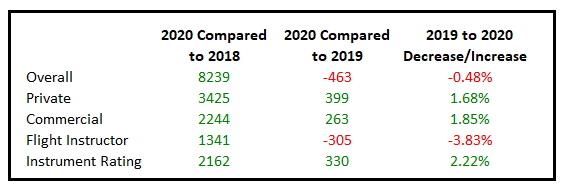With a year of uncertainty behind us there were questions about pilot certification numbers that many in the industry were asking. Did we keep training the next generation of pilots in 2020? How did flight training operations fair with shutdowns, very different business pressures, and a unique regulatory environment that was affected by local and national restrictions?
Just this past week, the 2020 US Civil Airman Statistics (https://www.faa.gov/data_research/aviation_data_statistics/civil_airmen_statistics/) were released and the data included allows some interpretation of what happened in 2020 compared with past years.
There is mostly good news in here with a little bit of expected bad.
Here are some highlights from the 2020 year and some comparisons with previous years.
Overall, an extremely minimal reduction in overall Pilot Certificates Issued
In a year when many businesses were closed, or at reduced capacity, and when we know that many flight training providers did experience at least temporary stoppages in training provision, the rally that was experienced is impressive.
Compared to 2019, 2020 saw an overall reduction in pilot certificate issuance of a mere 463 certificates, or an equated 0.049% compared with 2019 and was still an increase over 2018 of 8239 certificates, a nearly 10% increase in pilot certificate production. The gist, the pilot training industry is jamming and churning through certification of pilots at a good pace and that didn’t slow down in 2020.
ATP Certificates Down
About mid-way through 2020, as the country managed its responses to COVID-19, most regional airlines stopped hiring new pilots due to reductions in the need for pilots as airline service needs were significantly reduced. Without an actively flying public, fewer flights were needed, and that meant fewer pilots were needed. Most of these pilots were put on reduced hours or even given time off. And airlines stopped running training courses that made ATP pilot certification happen.
Compared to 2019, 2020 production as a 52% drop in ATP certificate issuance.
While our country is beginning to return to some higher volumes of flight activity, we still haven’t reached the same production level of ATP certificates that we were seeing approximately one year ago at this time. We are seeing many airlines restart their training classes, so expect these ATP certification numbers to start to climb through 2021, but the loss of certification process in 2020 may create some gap in the numbers of hireable pilots in the short run.
For more detailed information specifically on ATP certificate pilot production, check out my post at, A Lost Year of Full ATP Pilot Certificate Production?
The reduction we saw in ATP pilot certification numbers was made up by increases in other areas when considering total pilot certification events.
Private, Instrument and Commercial Certificate Issuances were Up
The base certificates that are completed as pilots transition from new student pilot through ratings and certificates actually saw small upticks in 2020 compared to 2019 and remained significantly up compared to 2018.
While not up in large numbers, not being down in a year where many businesses in other industries stopped for a period of time or even went out of business, the fact that the flight training industry continued to produce future pilots is impressive. It is a testament to the dedication of the flight training industry’s ability to adapt to the changed conditions and keep churning out future pilots.
Specifically, here is what some of the numbers showed for total pilot certificates issued in the respective years for and for respective ratings/certificates:

When we compare this to increase or decrease percentages for these same categories, we find the following:

What does this mean going forward?
The pool of pilot training candidates kept going in 2020 and the flow of pilots who completed base level certificates and/or ratings that would then be eligible for future pilot employment. This is a good thing for the employment pipeline.
We do still see the total number of CFI certificates and ATP certificates out there climb, but the average age of those holders is increasing. This is a trend that at some point indicates we will see a major dropoff of CFI and ATP certificate holders as this population ages out of the pilot community. It is a trend to be watched over the next decade.
Numbers don’t tell us everything, but they can be interesting indicators and help us understand our industry and some of the trends when contextualized. 2020 was certainly an interesting year in many ways, but at least in terms of pilot training, it seems to have rallied in ways that many might have thought would have trended in different directions.
